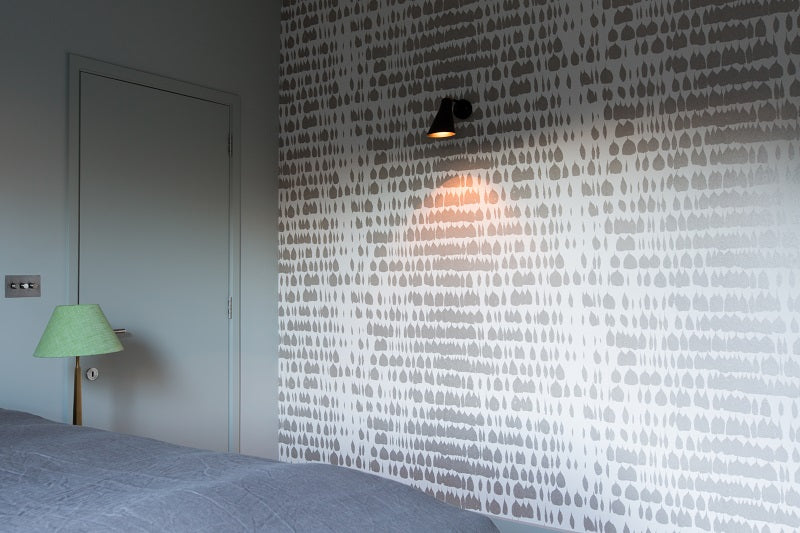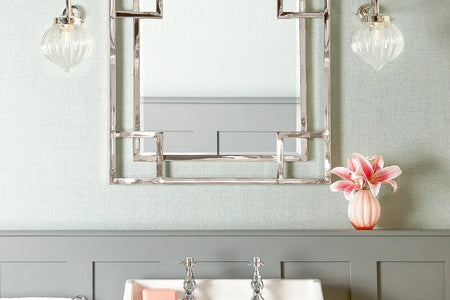
No windows - no problem! Read Pooky's top tips for lighting a room without windows...
Basements, bathrooms, guest bedrooms, study rooms, dens... all quite often lacking in natural light, though sometimes it might be one of your main reception rooms. Lighting a room with no windows can pose some challenges, but a windowless room certainly doesn't have to be soulless. In fact, this is when the right lighting scheme can really come into its own.
When lighting a room with no windows, some strategically placed lighting can make all the difference. The key is to use a range of different light sources to create the light you need, and to layer your lighting to create a sense of space and airiness. Here's our guide to creating the right amount of light, and adding style and ambience to your room, even in the absence of windows…

Tip: Place statement lights strategically to light important areas. Image: Claire Botha, Geek Vintique
How much light do you need in a room with no windows?
In a room with no natural light, you will need to supply all of the required illumination. The exact level of light you need in a room will depend on a number of things, including the size and shape of the room, what it's being used for, and the kind of ambience you’re looking to create. You can calculate the basic level of light (or lumens) you need using a handy formula. As a rule of thumb, a sitting room or bedroom will normally need around 10-20 lumens per square foot, while a bathroom or kitchen will require around 70-80 lumens. To work out the lumens you need, simply multiply the square footage of the room by this figure. (For more on lumens, see
How much light do you need in a room?) As well as providing enough overall light, it's also important to consider the type of lighting you’re using. Introducing a number of different light sources into a windowless room can help to lift the space and prevent it from feeling dark or enclosed, as explained below.

Tip: Layer light with multiple light sources. Image: My-Studio
Layering light in a room with no windows
There are three main types of lighting:
ambient lighting (the overall level of light in a room, including the main light plus any lamps etc);
task lighting (stronger, more targeted lighting for cooking, reading, etc); and
accent lighting (for highlighting architectural features, ornaments or artwork). By combining these different types of lighting - known as ‘layering’ light - you can provide plenty of practical light while also creating mood and ambience. When lighting a room with no windows, you should aim for balance within the space. Try to avoid making certain areas particularly bright at the expense of others, as this will emphasise any dark corners, making the room feel smaller and more enclosed. The right ambient lighting is particularly important for creating a sense of brightness and airiness. In a sitting room or bedroom, a large overhead fixture such as a stylish
glass pendant light will help to draw the eye, while a glass or crystal
chandelier will provide a stunning focal point which reflects the light beautifully. As well as reflecting light downwards, many pendant lights are designed to reflect some light upwards towards the ceiling, helping to illuminate a wider area. In a kitchen, a single striking pendant, or a row of pendants, are also a great source of practical task lighting when placed over a kitchen island. You can supplement your main overhead lighting with lamps and wall lights. A set of matching glass
wall lights will wash light across the wall and ceiling, emphasising the space. Meanwhile, adding in some
table lamps and a tall, slim
floor lamp or two will offer useful task lighting, while also adding warmth and ambience to corners and alcoves. Finally, use accent lighting to highlight favourite features or areas of the room and create a sense of depth. Place wall lights, spotlights and recessed lights in alcoves, between beams, underneath cabinets or inside shelves and bookcases. Layering your lighting in this way gives you more control over the atmosphere you want to create. Simply add in a dimmer switch and when the evening comes, you can dial down the main lighting and relax. (Just don't forget the dimmable bulbs!) Find out more in our
guide to layering light here.
Choosing light fittings in a room with no windows
The style and material of your light fittings can also affect the sense of light and atmosphere in a windowless room. To maximise the available light, opt for reflective metallic fittings in silver, chrom or or brass combined with blown glass, prismatic or sheer shades - or make a bold statement with a stylish standalone
designer LED filament lightbulb. It's also important to consider the 'colour temperature' of the lightbulbs you're using. This is measured on the Kelvin scale, with cooler, bluish white light at the higher end of the scale - this is closer to natural daylight; while lower down the scale is warmer, yellower light which has a more cosy, relaxing feel. Try combining a daylight style bulb in your main overhead light, with a warmer hue for your table lamps and floor lamps.

Tip: Make use of mirrors to maximise available light and prevent a claustrophic feeling. Image: Barbara Ramani
Using mirrors in a room with no windows
Mirrors are an excellent way of maximising the available light and adding depth to a space. In a room without windows, a mirror can be used to simulate both the look and effect of a window. Adding a large mirror or a series of mirrors to a wall will give the room an attractive focal point. Meanwhile, hanging a mirror opposite a doorway can reflect additional light into the space from other rooms. In a sitting room or dining room, try placing a large mirror above the fireplace or on a feature wall. Position the mirror so it can reflect back light from the overhead light fitting, or try adding a wall light on either side for a balanced look. You can also place mirrors behind table lamps and wall lights, to reflect the light and add extra ambience. In a bathroom, the mirror is often a focal point of the room, and a pair of wall lights looks perfect placed either side of the bathroom mirror for a flattering, even and glare-free light. (You can find out more about what designer lighting works best in a bathroom, and the safety considerations, in our
guide: Using designer lighting in a bathroom.) Meanwhile, in the bedroom, add a large mirror above the bed to create a stylish feature and reflect the light from the main overhead pendant or chandelier, or flank it with a pair of pretty
bedroom wall lights. A table lamp by the dressing table mirror will provide useful task lighting, while also creating a relaxing glow. And try using a full-length mirror combined with a stylish floor lamp to open up any darker corners.
See Pooky’s range of affordable designer mirrors here.
Tip: Use a light colour scheme to make the space feel bright and airy. Image: Lucinda Griffith
Other ways of creating light without windows
As well as the lighting scheme, there are a number of other ways you can maximise the sense of light and space in a windowless room:
-
Use doors that maximise the light from neighbouring rooms - using glass doors, doorless arches or double-doors can help bring in the light from hallways or neighbouring rooms that have more natural light
-
Opt for a light colour scheme - using lighter colours on the walls and ceiling, such as whites, creams, beiges and pastels, will help to reflect the light and make the space feel more open
-
Choose clean, simple lines - keeping to light coloured fabrics and slim furniture with clean, simple lines will help to make the room feel less fussy and more spacious
-
Incorporate light-emitting decoration - neon artworks and LED features will help boost the overall light. A large painting or print lit by a picture light will create a bright focal point
-
Use reflective surfaces - using metallics and other reflective surfaces will reflect the light and make things feel brighter. Think glossy walls, mirrored cupboards, and metallic frames and home accessories.

Tip: Incorporate light-emitting decor, such as picture lights and neon. Image: Emily Murray, The Pink House
With a bit of planning and the right lighting strategy, you can create a room that's bright and beautiful.
















